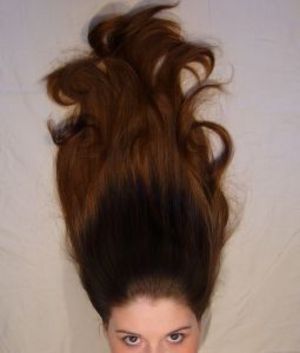If you color your hair, particularly if you lighten your lochs more than two shades, you’ve probably incurred at least some damage to your hair. The amount of damage you’ve sustained may be magnified if you do other processes such as perms or if you spend time in the sun. The everyday things you do to your hair can also contribute to hair color damage such as blow drying and using hot rollers. How do you know if your colored hair has been damaged?
You may have obvious signs of have hair color damage. If you find that your brush and the floor are filled with hair after styling, chances are you have damaged hair. The breakage may be obvious when you look at your hair and your hair may feel thin and dry. A quick test to assess whether you have hair color damage or damage due to any other type of processing is know as the “sink” test. To do this quick assessment, cut of a single strand of hair and place it into a sink full of water. Tap the strand lightly with your finger and observe. If you the hair strand sinks, you have damaged hair. If it floats, you’re hair passes the taste and probably isn’t overly processed or damaged.
If your hair fails the sink test and you have potential hair color damage, what can you do?
Hair color damage tip: Reassess your hair coloring technique
If you’re coloring your own hair, you may want to consider consulting with a professional hair colorist who can help you determine the best hair coloring products for your hair color and type. Damage usually occurs when you try to lift your hair too many shades or if you use damaging bleach. Consider coloring your hair only a shade or two lighter than your natural hair color which will not only will reduce damage but will also make your hair look more natural and require less upkeep.
Hair color damage tip: Protect your hair from the sun
The sun not only can damage color treated hair, it also can alter the color. When you go outside, particularly if you’ll be in direct sunlight, wear a straw hat or cap to protect your hair. If you’ll be swimming in a chlorinated pool, always wear a bathing cap. Chlorine and hair color don’t mix. It may also help to use a leave in condition with an added sunscreen.
Hair color damage tip: Protect your hair from heat
Limit the use of blow dryers as much as possible. When you do blow dry, use a thermal protecting spray and don’t blow hot air until it’s completely dry. Leave your hair slightly damp to reduce heat damage. You can also use your blow dryer on the cool setting.
Hair color damage tip: Protect your hair daily
Use a shampoo specifically formulated for dry, color treated hair and follow up with a moisturizing condition. Do weekly deep conditioning treatments to add supplemental moisture. Treat your delicate, color-treated hair gently by not brushing it when it’s wet or damp. A wide toothed comb should be used when the hair’s wet without tugging, pulling, or adding additional pressure to the hair shaft.
By making the right hair coloring decisions, using the right products, and practicing a little extra TLC, you can reduce the amount of hair color damage you have to deal with on a daily basis. Plus, your hair will look and feel more shiny and healthy.


